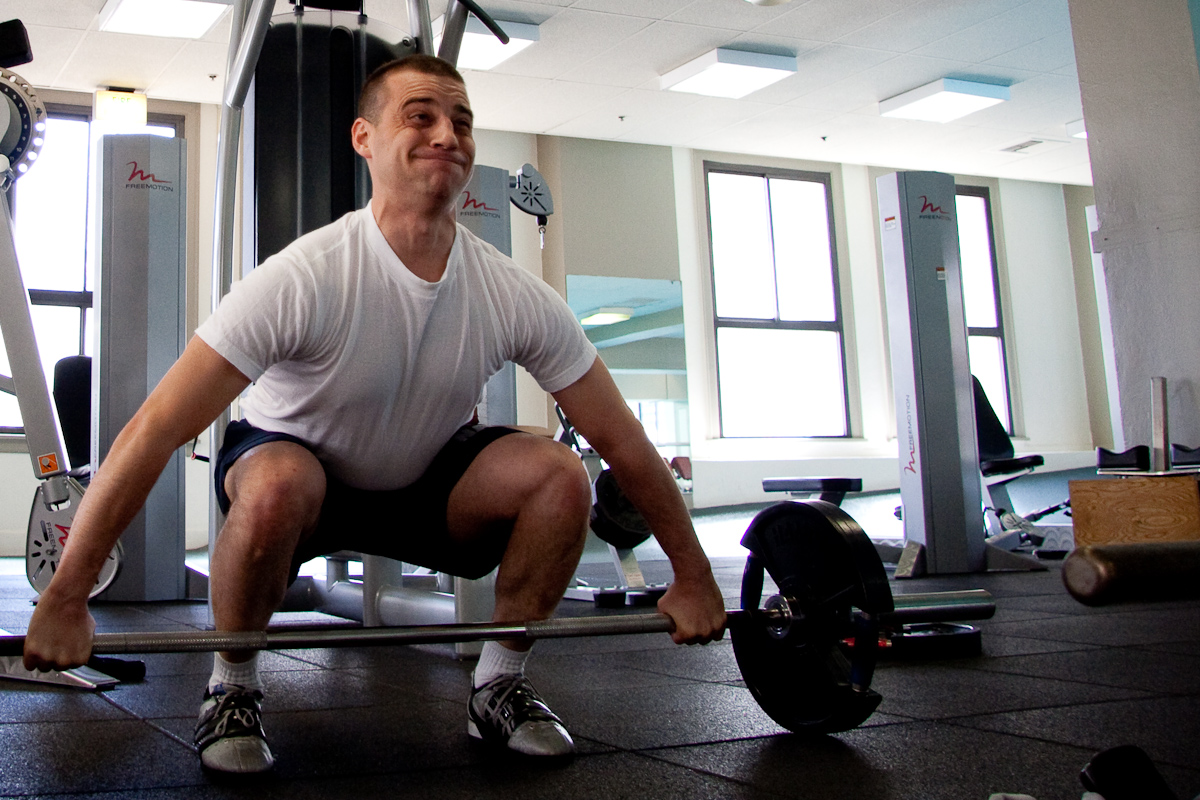Speed is a key element of athletic prowess. Many athletes are training directly for speed because their sport requires it; even pure strength athletes like powerlifters use speed training to increase their lifts. Just look at Westside’s training plans; they always include a weekly speed day.
Also, speed feels good: training fast makes you feel fast, and it’s addictive. Once you start using fast lifts you don’t usually stop. And it’s great to see people pursuing real, functional athleticism.

Speed training can be dangerous. And you don’t have to drop a barbell on yourself to get hurt.
If you’re training slowly, the bar has mass and weight, but little momentum. If you let go of it, it would just fall to the floor. Not a good look if your gym doesn’t have bumpers, but at least it’s predictable. If you train fast and lose control, the bar has enough momentum to be unpredictable. And if you lose control but keep hold of the bar, it’s heavy enough and moving fast enough to make a mess of your back, knees or shoulders before it comes to rest, wrenching your joints and damaging your muscles. Training speed requires more forethought than lifting slowly.
What are the top 4 mistakes athletes make in the weights room and what are the fixes?
Mistake 1: Poor Movement Selection
What?
Training for speed can take two forms. You can take a specific movement, the one you’re going to use on the day, and work with lighter weights to train for maximal bar velocity. But that only really makes sense if you compete or participate in a strength sport. If you’re lifting to improve your soccer, rugby or tennis performance, speed isn’t going to be patterned. It’s going to be neurological. That means it’s a function of the nervous system, an expression of your whole organism’s ability to move fast.
Why?
If you wanted to get stronger so your tennis would be better, which of these approaches makes more sense: lying on a bench and doing mock tennis strokes with an end-weighted dumbell or club bell, or bench presses?
Obviously it's the bench presses. They don’t mimic the tennis strokes you want the strength for — but neither does the clubbell. But they do build the strength that will support your sporting skill. Strength is a skill, speed is a skill, but they’re transferable, general skills.
READ 4 Muscle Myths Holding You Back
How?
Use safe, simple, compound movements to work on speed. If your squat is solid, fast squats can be a good choice, but they’re hard on the CNS and if your form deteriorates and you try to come up out of the hole fast it’s an injury waiting to happen. Try using fast deadlifts, fast benches and incline benches, and medicine ball slams if you can.
Top Speed Training Mistakes
Mistake 2: Poor Force Pattern Selection
What?
All too often, athletes and even their trainers fail to draw a distinction between speed expression and power expression. But they’re very different things. Speed is about how fast you can move. Power is about how fast you can accelerate.
As an example, watch an Olympic lift. They start out slow, suddenly accelerate and then slow again. They’re about power, not speed. Lifts that privilege power over speed are a great choice if you’re trying to develop power. But it’s not so great if speed is the attribute you’re trying to develop.

Why?
Mainly it’s because many athletes don’t stop to think about the difference between fast and quick. Power is about being quick, but speed is about being fast. They’re separate attributes and they need to be trained for differently. So when the program calls for moving a heavy weight with great acceleration,that’s power, not speed.
How?
Either shunt power exercises to a dedicated power portion of your training, or accept that power isn't what you’re training for. If you want to train for speed, look for long range of motion compound lifts where you can attain and keep a high bar velocity.
Mistake 3: Poor Load Selection
What?
Moving loads that are far too heavy is a really common speed training error. It’s ironic, because many athletes are actually lifting loads that are too light during their strength training, but their speed training is often far too heavy. Strength is best done somewhere between 85 percent and 95 percent of your 1RM, but speed training should be done with about 40 percent of your 1RM.That means if you deadlift 200lb, you should do speed training with 80lb. If it feels light, you’re doing it right!
Why?
Speed is about attaining a high bar velocity. Power is about accelerating a load. You want a load low enough that you can move it fast, over a sufficient period of time to build speed as an attribute at the muscular and nervous level. But athletes don’t always know how comparatively light they need to go with speed training. It’s part of a general tendency for training for different attributes to end up being too similar.
How?
Start light if you have to. Again, make sure your patterning and movement selection is solid. You don’t want to be doing fast bicep curls speed is an all-at-once, whole-body attribute. And start light. If you’re in doubt, start with an empty bar — yes, really — and see how fast you can move that. You want to load a fast movement, not accelerate a heavy one!
Mistake 4: Poor Understanding Of How Speed Training Should Feel
What?
All too often, speed training gets consumed by general conditioning. But it’s not cardio. You’re going to sweat and get out of breath, but those are side effects, not what you came to do. Speed training requires sufficient rest that you can continue to perform at roughly the same speed throughout that portion of your training. If you’re slowing down, either the bar’s too heavy or you’re doing cardio by accident. How can you train to go fast by going slow?
Why?
Sometimes the person who programmed the speed training doesn’t really understand what it’s for. Sometimes athletes just regress to what they know: working hard and getting smoked. People who don’t like hard work aren’t even in the weight room, so getting that burn is a familiar feeling to lifters and game players. But it’s not what speed training is for! Sometimes it’s people trying to get two for the price of one: you see plyometrics or power training programmed the same way. The rise of HIIT, otherwise almost entirely a good thing, is somewhat to blame here too.
How?
Make sure that you’re getting adequate rest between sets and that sets are short enough to maintain bar speed. This is loading, rep and set schemes, but it’s attitude too:the goal isn’t to feel anything in particular, it’s to move the bar consistently fast.
Mistake 5: Poor Understanding Of Crossover
What?
Westside Barbell’s famous speed days are actually a bad tjhing in some ways, because they make toomany non-powerlifting athletes blur the line betwen lifting fast on one hand, and being fast on the other. Lifting fast is about fiber recruitment, force development and neurological factors, just like being fast. But it’s also a skill you directly practice in the weight room, something that just isn’t true if you’re playing another sport.
Why?
Mainly because people copy something that works instead of taking it back to first principles and analysing what will produce the results they need for their goals.
READ Post Workout Nutrition For Weight Lifting Routines
How?
Use just a few simple compound movements. Make sure they’re safe. And don’t focus on technical lifts. Look for moves that can be done easily with low technical requirements so you can focus on speed as an attribute, not speed as a skill. If you find that compound lifts like deadlifts are technical for you, it might be time to put the barbell down and do your speed training with a sled or by throwing a sandbag.
- Photo courtesy of The World According To Marty via Flickr: www.flickr.com/photos/martijnvandalen/5363964230
- Photo courtesy of The World According To Marty via Flickr: www.flickr.com/photos/martijnvandalen/5363964230
- Photo courtesy of johnclegg via Flickr: www.flickr.com/photos/jonclegg/4457694598


Your thoughts on this